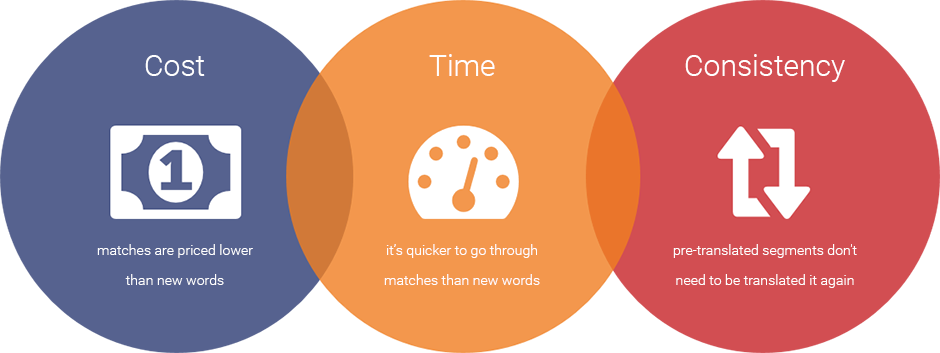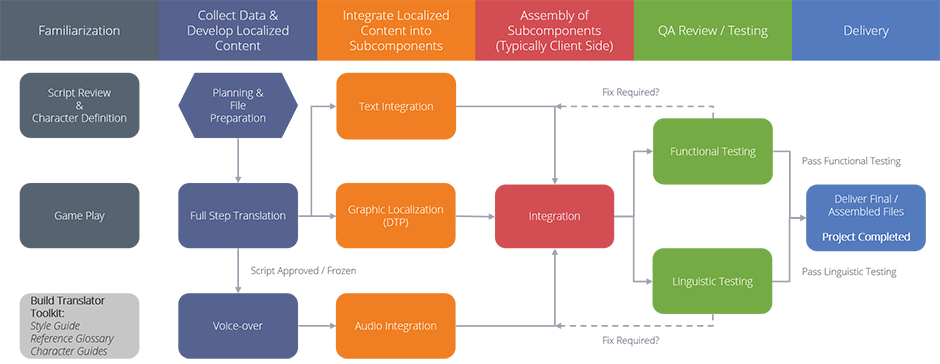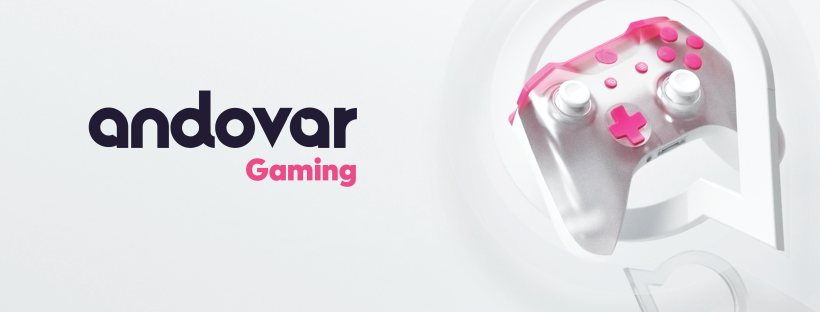Gaming localization is becoming more important than ever and smart publishers know that nowadays they need to look at not only French/Italian/German/Spanish or Chinese/Japanese/Korean, but also at languages of emerging markets. Why?
Have a look at the below world map showing market share and pace of growth for games in the four main regions:
.png?width=740&name=Newzoo-2020-Global-Gamers%20(edit).png)
Of course, there are games and there are GAMES. The first ones being simple and with little text, mostly free or cheap downloads from the mobile app stores or on social sites like Facebook. The ones that can be enjoyed during a taxi ride or while queuing at the supermarket. However little text there may be in them, they still need to be localized in order to get the most traction in each international market. However, this blog post is about GAMES, the ones that cost big bucks and take weeks or months to finish; or you just never finish them, as is the case with some of the biggest MMOs out there. They can include hundreds of thousands of words, hours of audio recorded by a full cast of actors and they are an especially difficult, yet rewarding challenge for localization providers. So how does Andovar approach them?
While we pride ourselves at customizing our solution for each client and project depending on the specific requirements and limitations, our typical process would include the following.
Analysis and quotation
We look at the files from the client and have our localization engineering team analyze them to determine the best approach to extract translation assets and find as many repetitions and matches as possible. We can work with content in any type of files, but the most suitable formats are ones that follow these criteria:
- easy to extract (e.g., a simple file copy or database query).
- regular, that is, easy to parse or filter.
- obvious what needs to be translated and what does not. That is, inline tags or code are regular, and content separated from other types of data.
- easy for the client to re-integrate localized content back into the build environment.
Sometimes clients believe that in order for a localization company to quote, they need to provide their files in a “friendly” format, such as Microsoft Excel. This is not necessary and unless done by a localization engineer, can actually cause more problems than it solves. Poorly converted files make the job of analysis and matching more difficult and time-consuming. Of course, in some cases, our clients are publishers and don’t have any choice when it comes to what file formats they can provide.
The key metric in analysis is the total word count or in the case where source is a language like Korean or Chinese, the character count. The tools our engineers use for analysis can usually determine easily what the total number of words or characters is. However, some Southeast Asian languages like Thai pose an additional difficulty, because there are no clear definitions of what constitutes a word and no spaces between words to help. Word counts provided by localization tools will almost always differ from what Microsoft Word shows, but in such languages the differences will be even greater.
There are two types of repetitions or matches we encounter: translation memory (TM) matches and internal matches. The first type requires an existing TM from previous projects and the tools would look for segments in the new files that are exactly or almost the same as in the TM. We sometimes work with clients who have localized before, but the previous translations are not in a TM-friendly format. In most cases, it is still possible to make use of them by retro-creating a translation memory. Maintaining a good quality TM is very important especially in the case of large games which get updated over time. The main benefits are:
- lower cost of new translations - because matches are priced lower than new words;
- faster turnaround times - because it’s quicker to go through matches than new words.
- more consistency between projects/updates - because whenever a segment had already been pre-translated, it won’t need to be translated again;

The engineering tools determine the level of matches automatically by comparing all segments both internally and with the TM. A segment which is exactly the same would be a 100% match – also called a repetition. A segment which not only the same, but is also surrounded by other repeated segments would be a 110% match (also knows as ICE - In-Context Exact), which means even higher confidence that it doesn’t need to be retranslated. Matches below 100% are determined based on the level of similarity with existing translations. In gaming projects, we can often go as low as 50% matches, since segments such as Golden Coin, Silver Coin, Platinum Coin, etc. can benefit from the technology.
Andovar charges for translation on a per-word basis on a sliding scale depending on the level of matching. New words charged at full rate and matches at 25-75% less. Depending on the project, even 100 and 110% matches are briefly checked by our linguists, because although the text may be exactly the same, the context may be different. If that is the case, a 100% match would be worded differently than it was previously.
Preparing translation assets
If the quote is accepted, it is very important to have a translation termbase of common game terms (names of main characters, locations, items, quests, brand names, etc.) with their approved translations in all target languages, what parts of speech they are, examples in context and other guidelines on usage. This termbase is usually created in collaboration between us, the developer, the publisher, our linguists and often the gaming community. Depending on the size of the game, it can take a while to agree on all terms, but having this pre-approved termbase is a fundamental requirement for confident and consistent localization. Without it, translators would translate the same terms or names differently within one project or between updates, which would result in a confusing and poor experience for players.
The second important asset is a style guide. This is a document that includes guidelines about style that will be appropriate for the specific game, such as whether the language should be casual or formal, should use a medieval way of speaking or maybe futuristic. It can also go into specifics of using punctuation, capitalization, units of measurement and spelling. Similar to a termbase, a style guide is created before localization starts and in cooperation with all parties. Both of these documents are updated as needed during the lifetime of the game whether within one project or between updates.
The third important asset is the translation memory, which I’ve mentioned earlier. You need to be sure that all translations are saved in a correctly formatted and updated TM for the specific game and can be reused to make future work quicker, cheaper and more consistent with previous translation. Some localization companies may not share TM with the clients to make it more costly to switch vendors, but Andovar doesn’t condone this practice.
For storyline-driven titles with many characters with developed in-game personalities, it is usually a good idea to create a forth type of asset – called a character guide. This document lists all main characters in the game along with their images, bios, personality traits, styles of speaking, mannerisms, attitudes towards other characters and roles in the game world. All this serves as a quick reference point for translators and voice-over artists.
A different type of asset are reference materials that help everyone get an understanding of the game world. These can be screenshots of the different game areas, a playable version of the game or background information, such as a link to the website or game discussion forum.
Linguist recruitment
Andovar offers translation services in many industries, but it doesn’t mean we use the same translators for all jobs in a given language pair. For a gaming project we only use linguists with experience not only in gaming, but also in the specific game genre (fantasy MMORPG, for example). All our linguists have to pass a three-step testing process and whenever possible we work long-term with the best ones, while replacing ones that have not provided the quality and professionalism we were looking for. We can also involve the client in the recruitment and selection process to help them choose the people whose style and experience is the best match for the project.
Our translators and editors are typically native speakers of the target language and live in the countries where the game is meant to be published; if it is aimed at China, we would work with translators based there. This assures that they not only have the language skills, but also a deep understanding of the culture and habits of the in-country population.
Whenever possible, before the project starts we allow time for the selected linguists to get them familiar with the game by studying the supplied reference materials or playing the game itself, if available.
Project management
Once the assets and linguists are ready, we kick-off the project and assign a project manager. It is their job to distribute termbases, style and character guides, TMs and pre-engineered files to all approved linguists and make sure they understand all instructions. Should the linguists have comments or questions, the project manager would liaise with the client to answer them.
The typical process involves first translating all the content and then sending it to editors who check to make sure the quality is high and that all instructions have been followed. During the process, the translation assets are continuously updated.
Audio/Subtitling
Andovar has its own on-site audio studios in Bangkok to record new audio for the game trailers and cut-scenes in all commercial languages. It is best when we have access to the source language audio and video content to use as reference. Usually, our clients tell us what kind of voices they are looking for and we send them samples from appropriate talents from our database. If that is not enough, we can also organize special casting sessions where candidates would record sections of the actual game scripts. It is important that translated scripts are thoroughly checked and approved by all parties before recording begins. Audio retakes cost much more than fixing the translation beforehand!
In some cases, especially for games with a lot of audio, our clients opt for subtitling instead. This is a much less expensive solution and allows completing the process much quicker than in the case of recording audio in all new languages.
Desktop publishing
Many games include images which need to be localized. Sometimes it is only the title or splash page and sometimes there are hundreds of them spread throughout the game. If source files supplied by the client are in a format where text is on a separate layer from graphics, localization means extracting the text, translating it and then integrating with the image again. This last step may require adjusting font sizes, shortening words, using acronyms or resizing fields in order to accommodate strings that have changed length after translation.
However, if there are no layered sources files with separate text and graphics available, localization of images involves more work. Images need to be either recreated from scratch or edited with graphic software to overlay the source text with translations. The latter process is simpler and quicker, but does not always provide optimal results.
Quality control
All our linguists work in Computer-Aided Translation (CAT) Tool environment, which means that basic quality control is always in place and that they are only working on translatable text and code is hidden, so it can't be altered by accident. Additionally, once both translation and editing are finished we conduct an in-house quality assurance process. This involves automated checks for issues that are easy to miss for the human eye, such as:
- missing punctuation
- wrong capitalization
- spelling errors
- text that wasn’t extracted
- many, many others…
There are dozens of checks done before the translation gets final approval.
Reintegration and delivery
Once all quality check are done, it is time for the engineers to reintegrate the translated text, localized images and new audio with the remaining assets and create new localized files in the same format as source. Our deliverables are the localized files, updated termbase, style and character guides, translation memory, plus any comments or suggestions our team would like to forward to the client.
Testing
If client requests, we also provide testing services:
- Functional testing which means making sure that the localized builds work correctly and the game has all the same functionality as the source; and
- Linguistic testing which focuses on accuracy of translation when seen in context. In gaming localization it is often the case that linguists have to work on strings without any context and this can introduce less than optimal translations.
For complex games, it is important to create a test plan before testing begins. It is a document giving instructions to testers on what they should do to ensure all areas/screens are checked. This is yet another translation asset, which should be created in cooperation with the client.
We localize more and more mobile games and it’s important to remember that testing should take into consideration different screen sizes and devices the game will run on. This is especially pertinent in the case of Android applications, since due to the fragmentation of the hardware marketplace, there are dozens or even hundreds of devices the players might use, each with slightly different screen dimensions, resolutions and capabilities. On the other hand, Apple controls the hardware side on the iOS environment and the number of devices is restricted.
Wrapping up, the complete overview of a complex game localization process could be summarized as below:

I hope this article is detailed enough to answer the most common questions without being too technical as to be difficult to understand. Of course, at Andovar we are always happy to listen to any questions you may have and help you make your game clear in any language!
For more insights into games localization, visit our Ultimate Guide to Games Translation.












